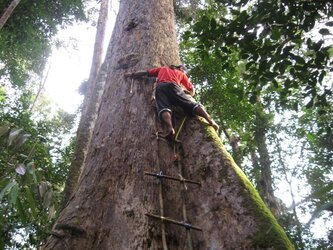

Scaling trees for science
A new era of forest monitoring is quite literally taking off, ushering in what scientists are calling the ‘forest space age’. On April 29, ESA will launch its revolutionary Biomass mission, the first satellite to carry a P-band radar into space – technology that is set to transform how we understand forests and the carbon they store. Along with other space agencies’ instruments already in orbit or soon to be launched, there has never been so many ‘eyes in the sky’ focused on forests.
Yet, the work of people on the ground –often in the most remote and challenging forest regions – also remains essential. This is where the global network of forest scientists, botanists and technicians comes in – many of whom work in challenging, under-resourced and often dangerous conditions.
Accurately measuring and identifying trees in tropical forests needs skill and courage. To measure the diameter of a giant Ceiba in Colombia’s Pacific Rainforest, three researchers from the Forest Plots partner network ‘Col-Tree’ climbed 12 metres. This is the most practical, accurate way to measure large trees when there is no power and scanners are not deployable.
Read full story: A new space age for forests – but groundwork still matters





